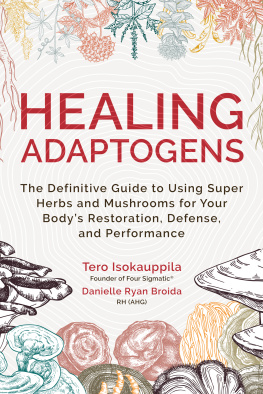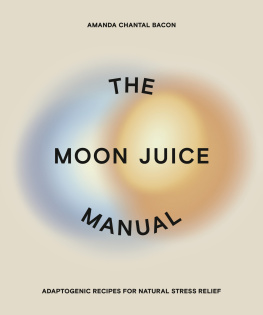Contents
Guide
Adaptogens
75+ Herbal Recipes and Elixirs to Improve Your Skin, Mood, Energy, Focus, and More
Agatha Noveille

Avon, Massachusetts
Copyright 2016 Simon and Schuster
All rights reserved.
This book, or parts thereof, may not be reproduced in any form without permission from the publisher; exceptions are made for brief excerpts used in published reviews.
Published by
Adams Media, an imprint of Simon & Schuster, Inc.
57 Littlefield Street, Avon, MA 02322. U.S.A.
www.adamsmedia.com
ISBN 10: 1-4405-9639-5
ISBN 13: 978-1-4405-9639-1
eISBN 10: 1-4405-9640-9
eISBN 13: 978-1-4405-9640-7
The various uses of herbs as health aids are based on tradition, scientific theories, or limited research. They often have not been thoroughly tested in humans, and safety and effectiveness have not yet been proven in clinical trials. Some of the conditions for which herbs can be used as a treatment or remedy are potentially serious, and should be evaluated by a qualified healthcare provider.
This book is intended as general information only, and should not be used to diagnose or treat any health condition. In light of the complex, individual, and specific nature of health problems, this book is not intended to replace professional medical advice. The ideas, procedures, and suggestions in this book are intended to supplement, not replace, the advice of a trained medical professional. Consult your physician before adopting any of the suggestions in this book, as well as about any condition that may require diagnosis or medical attention. The author and publisher disclaim any liability arising directly or indirectly from the use of this book.
Cover design by Stephanie Hannus.
Cover and interior images iStockphoto.com/Ekaterina Skorik; iStockphoto.com/Lillia.
This book is available at quantity discounts for bulk purchases.
For information, please call 1-800-289-0963.
Introduction
The human quest for longevity, youthfulness, and rejuvenation has spanned hundreds of years and taken many forms. From the medieval fascination with alchemy and the elixir of life to the modern fascination with superfoods, it seems that we have always had a drive to do more, be more, and set new standards for health and vitality.
Many years ago, the Soviet Union instructed their scientists to open a new chapter in this quest. They were ordered to search for and develop substances that would allow their athletes, military personnel, and even chess players to excel above and beyond, to have an edge in stamina, strength, endurance, and mental abilities that would bring them international glory. After much work, these scientists focused their research on, of all things, herbsa very specific group of herbs that became known as adaptogens. American ginseng, eleuthero, rhodiola, and holy basil are just a few examples of the plants that we now know as adaptogens. These remarkable plants have been shown to have a gentle but measurable influence on immunity, sleep, stress levels, energy, and endurance.
Whether you are interested in honing your mental abilities to a razor-sharp level, want to give your athleticism a boost, or are looking for ways to include tonic herbs as part of a healthy lifestyle, adaptogens have so much to offer for everyday well-being.
There are fabulous resources available to teach you about the many traditional uses and modern research regarding these herbs, but this book is different. It shows you how to take these amazing herbs and add them into your daily routines with flair! By making your own extracts, elixirs, and teas, you will save money, have a high-quality product, and end with something thats unique rather than an off-the-shelf product. You can tailor your creations to be exactly what you want or need them to be!
Adaptogens lend themselves well to a variety of creative recipes, and working with them in this way is a pleasure. Rather than another expensive vitamin pill to pop or a bitter-tasting herbal extract to pinch your nose and toss back, you can experiment with tasty teas, yummy syrups, or fun and interesting snacks to incorporate adaptogens into your life.
Adaptogens can become a valuable part of your healthy lifestyle. They are also a great way to begin working with herbs in general. Thanks to their safety (an herb must be nontoxic and safe for extended use to qualify as an adaptogen), they are some of the easiest and most accessible herbs to work with for the everyday person. With a few general guidelines in place, you can approach these herbs with confidence. Turn the page to find out what you need to get started creating your first DIY adaptogen recipes, and follow in the footsteps of others who have explored some of the most compelling quests in human history: How much can we do? How much can we become? What is the full potential for our health and vitality?
Part 1
The Basics of Adaptogens
Chapter 1
Understanding and Using Adaptogens
Many people are looking for ways to be healthy that go beyond the vitamin bottle. They are looking for ways to increase vitality that are less about taking a pill and more about making different lifestyle choices, incorporating nutrient-dense foods, and utilizing the basic tenets of many ancient forms of healing, including herbalism, into daily life. During this quest for optimum health and vitality, many people come across the concept of adaptogenic herbs.
What Are Adaptogens?
The concept of plants with revitalizing or restorative properties that can enhance health has been around for thousands of years, although adaptogen is a modern word that has only been used to describe them since the 1940s. Many of the herbs that we know as adaptogens today were first used many generations ago in Ayurveda (the traditional system of herbalism in India) and in traditional Chinese medicine (TCM).
In Ayurveda, for example, herbs such as amla, shatavari, and holy basil are classified as rasayana herbs. Rasayanas are herbs that increase vitality and were believed to promote youthfulness and increase resistance to illness. In modern herbalism, we use these three herbs along with many other rasayanas as adaptogens.
One of the concepts of traditional Chinese medicine groups herbs into three categories based on their actions and safety of use. Many herbs in the first category, sometimes translated as superior herbs, are valued for their tonic and harmonizing influence on overall health. Many herbs that we know as adaptogens today belong to this class of herbs, such as he shou wu, eleuthero, and schisandra.
A pressing question for many people when they begin using adaptogens is: Should I take a break from using adaptogens? If so, how often? Adaptogens actually seem to work better with regular use, and you dont usually need to worry about them putting a particular strain on the body or your body building up a tolerance. Personally, I like choosing one adaptogen to use at least once a day for a few months at a time before switching over to another or taking a rest. I find that it helps to periodically reevaluate my personal health goals and concerns when deciding which adaptogen to use. Our bodies change over time and it makes sense to change our adaptogens to match whats going on with our health.
So how did we come to describe these herbs as adaptogens? In the late 1940s, the government of the then-USSR instructed its scientists to create a substance that could be used to increase the performance of their athletes, military personnel, and even elite chess players, so that they could dominate and excel in every international arena.





